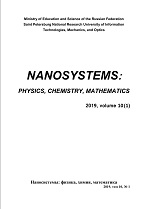|
This article is cited in 2 scientific papers (total in 2 papers)
PHYSICS
Instantons describing tunneling between magnetic states at finite temperature
S. M. Vlasovab, P. F. Bessarabab, V. M. Uzdinbc, H. Jónssonad
a Science Institute and Faculty of Physical Sciences, Univ. of Iceland 107 Reykjavík, Iceland
b ITMO University, Kronverkskiy, 49, St. Petersburg, 197101, Russia
c St. Petersburg State University, St. Petersburg, 198504, Russia
d Center for Nonlinear Studies, Los Alamos, NM 87545, USA
Abstract:
A method is presented for finding instantons in magnetic systems – optimal paths corresponding to tunneling from one magnetic state to another at a finite temperature. The method involves analytical continuation of the energy to allow for complex values of the angle variables. First, a set of discretization points are placed equally spaced on a chosen energy contour. Then, an estimate of the corresponding temperature is obtained using Landau–Lifshitz dynamics in imaginary time along the contour. Finally, the distribution of the discretization points as well as the energy are systematically refined by converging on the nearest stationary point of the Euclidean action, thereby obtaining a discrete representation of the closest instanton at the given temperature. The method is illustrated with an application to a system consisting of a single spin subject to uniaxial anisotropy and transverse external magnetic field. First-order and second-order crossovers from over-the-barrier mechanism to tunneling are found depending on the applied field, and the difference in the dependence of the instanton temperature on the energy illustrated for the two cases. By comparing the Boltzmann factors for over-the-barrier and tunneling transitions, the crossover temperature between the two mechanisms is estimated for both first- and second-order crossover.
Keywords:
magnetic transitions, tunneling, instanton, path optimization.
Received: 15.11.2017
Revised: 24.11.2017
Citation:
S. M. Vlasov, P. F. Bessarab, V. M. Uzdin, H. Jónsson, “Instantons describing tunneling between magnetic states at finite temperature”, Nanosystems: Physics, Chemistry, Mathematics, 8:6 (2017), 746–759
Linking options:
https://www.mathnet.ru/eng/nano100 https://www.mathnet.ru/eng/nano/v8/i6/p746
|

|




 Contact us:
Contact us: Terms of Use
Terms of Use
 Registration to the website
Registration to the website Logotypes
Logotypes








 Citation in format
Citation in format 
